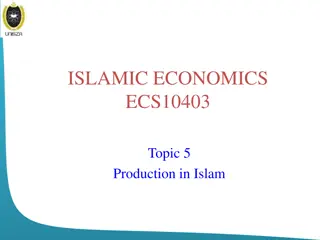Production, Economic Behavior, and Household Models in Agriculture Development
Exploring capital accumulation, production techniques, efficiency in farm-firms, and the role of agricultural households in economic development. The text delves into factors like risk management, sharecropping efficiency, and the impact of economic incentives on agricultural production.
Download Presentation

Please find below an Image/Link to download the presentation.
The content on the website is provided AS IS for your information and personal use only. It may not be sold, licensed, or shared on other websites without obtaining consent from the author. Download presentation by click this link. If you encounter any issues during the download, it is possible that the publisher has removed the file from their server.
E N D
Presentation Transcript
AGRICULTURE IN ECONOMIC DEVELOPMENT: AN INTERNATIONAL PERSPECTIVE WEEK 4 Production, Economic Behaviour and Household Models 1
Production, Economic Behaviour and Household Models Capital accumulation and the choice of production techniques The coexistence of production techniques in agriculture (Mundlak) Capital accumulation and the introduction of technical change Efficiency and economic behaviour of the farm-firm Schultz (1964) Transforming traditional agriculture Yotopoulos and Lau: a test for relative efficiency Addressing risk and uncertainty : multi-product production Efficiency of sharecropping Response to economic incentives prices The supply response issue and the work of (Nerlove, 1958) Implications for the operation of product and factor markets The model of the agricultural household Non-separability of production and consumption The role of the labour market 2
Bibliography Y. Mundlak (2001) Production and supply , ch.1 in HANDBKAGECON H. Binswanger, J.McIntyre and C. Udry (1989) Production Relations in Semi-Arid African Agriculture , chapt. 6 in BARDHAN Pan A. Yotopoulos and Lawrence J. Lau (1973) A Test for Relative Economic Efficiency: Some Further Results, The American Economic Review, Vol. 63, No. 1 Eswaran, M., and Kotwal, A. A Theory of Contractual Structure in Agriculture. American Economic Review, Vol. 75 (1985). Stiglitz, J.E., (1974) Incentives and Risk Sharing in Sharecropping Review of Economic Studies, vol. 41, pp. 219-55 Mergos G (1991) Output Supply and Input Demand in Greek Agriculture: A Multi-Output Profit Function Approach, Studies (New Series) No 6, Centre of Planning and Economic Research, Athens Stiglitz, (1982) Credit and Sharecropping in Agrarian Societies , Journal of Development Economics, December. 3
Mundlak - Production and supply : The issues 4
Capital accumulation and the choice of production techniques Capital accumulation and the introduction of new technology are interrelated Example the Green Revolution In a production function framework : labour is the main factor with capital and new inputs being introduced gradually (elasticities differ) The introduction of new technology follows a sigmoid curve Imperfect information lack of knowledge Risk and uncertainty - demonstration Capital non-homogeneity 5
The coexistence of production techniques in agriculture (Mundlak) 6
Capital accumulation and introduction of technical change in production economy level 7
Capital accumulation and introduction of technical change in production economy level 8
Tests of relative economic efficiency Schultz (1964) Yotopoulos (1967) Lau and Yotopoulos (1971 and 1973) Duality theory of production Profit function Cost function Cross-sectional farm survey data Perfect competition, sources of price variation and the sue of a profit /cost function Opportunity cost of labour lack of labour markets 11
Testing for relative efficiency Using duality theory (profit function) 13
The efficiency of sharecropping A perennial puzzle Persistent, coexisting with other forms of tenancy, It persists although inefficient, non inducing innovation, non conducive to technology adoption, shares determined by custom Approaches - Marshallian, landowner model, imperfect information model (new institutional economics), Marxian (exploitation model) Sharecropping links multiple markets Land and labour, but also credit, inputs, consumption Not always a clear cut landless/landowner distinction Often sharecropper small holder also
Farmsize productivity relationship Ideal productivity measure: = /unit of economic size Few empirical studies have come close to measuring this Those that have indicate a significant negative relationship between farmsize and profit for all but smallest farmsize classes Lots of empirical work shows this inverse relationship using /acre or output/acre. BASIC ANALYTICAL ISSUE : Large farm assets vs. Small farm assets Large: Scale economies (lumpy assets) Access to credit Superior (?) management skills, Small: Family L quality advantage, Supervision economies No search costs for family L Better land quality (?) POINTS Land rental mkts can dissipate decreasing returns to scale Empirical evidence (Binswanger & Elgin): tenants are less efficient than owners, but not by as much as expected Decollectivization can have positive impact IRS may be crop specific (e.g., sisal, sugar) and/or linked to tight processing or marketing requirements (e.g. bananas 16
The issue of response to economic incentives prices The issue: could we use prices and markets as a policy instrument to increase production and supply, in particular food supply ? The assumption of perfect markets perfect knowledge perfect competition does not hold in most developing countries. Is then price not the suitable policy instrument for increasing domestic supply, for production of goods for export markets, for improving nutrition If product supply is non-price responsive, then the only policy instrument for the government is to change the technological and/or social conditions Supply response has been an issue very early The Nerlovian model - Nerlove (1958). Econometric analysis using aggregate time series data & farm level data Seminal book by Askari and Cummings (1977) Agricultural Supply Response A Survey of Econometric Evidence The issue can be examined at three levels: at aggregate output, at commodity level, or marketed surplus 17
Output supply and input demand : duality theory The duality theory framework The cost function approach The profit function approach Christensen Jorgenson Lau : The theoretical framework Lau Yotopoulos in agriculture Binswanger, Lopez, et al Mergos(1991) Output supply and input demand in Greek agriculture, KEPE 18
Output supply and input demand : cost function 19
Output supply and input demand : cost function share equations 20
Output supply and input demand : profit function 21
Output supply and input demand : profit function share equations 22
The concept and characteristics of Farm Household models Rural HHs are systematically exposed to market failures (markets do not exist or high transactions costs, constraints on quantities marketed) Modeling rural household behavior in the context of market failures implies non-separability between production and consumption decisions. The non-separability concept introduced first by Lau and Yotopoulos (1974) and further developed by Singh, Squire, and Strauss (1986) A HH model is non-separable when decisions regarding production are affected by its consumer characteristics (consumption preferences, demographic composition, etc.). By contrast, in a separable model, the household behaves as a pure profit maximizing producer. The profit level achieved in turn affects consumption, but without feedback on production decisions. Examples: transactions costs on the market for a food product, inexistence land market, imperfect labour market, inexistence of credit market 23
Implications of non-separability Non-separability affects HH ability to respond to incentives It explains HH beehavior that otherwise appears irrational from an economically . Social anthropologists argue for non-economic behaviour (rituals, tradition, etc) Construction of household models with failures on food, labor, or manufactured goods markets explain this behavior in the context of economic calculus. Incomplete performance of markets induces behavior that seems contrary to economic logic, not a different logic specific to the peasant households For example a farm HH producing food and cash crops, faces two market failures, one in the food market and the other in the labor market A social athropologist would argue that the peasant household has non-economic objectives since it does not respond to a rise in the price of cash crops. However, lack of response to prices does not come from absence of economic rationality. It is due to lack of food market so HH cannot reallocate land toward cash crops, despite an increase in income and desire to consume more food Also, from lack of a labor market does not allow hiring workers to expand cash crop production and leisure constraint does not allow increase in own labour supply Thus, supply response of cash crops cannot come from a decline in food production nor from an increase in family labor. Therefore, only technological change by increasing use of purchased inputs such as fertilizers that are partial substitutes to land and labor would allow increase supply 24
Farm Household models: the Strauss paper (1983) that led to the book Singh, Squire, and Strauss (1986) book 25

















































